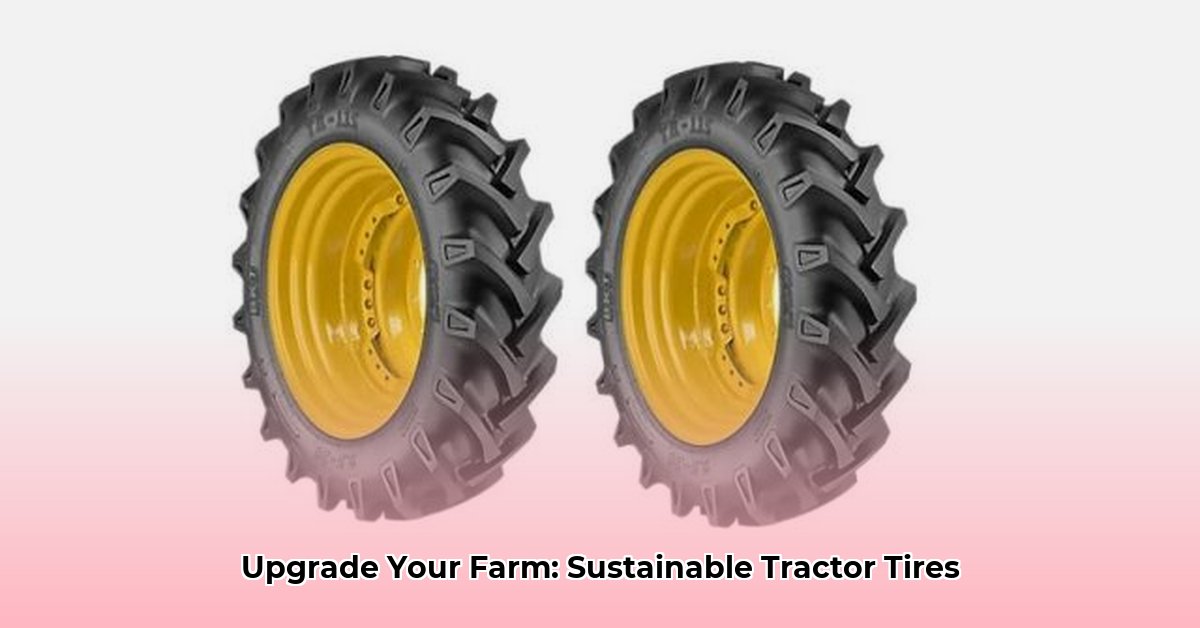
Choosing the right tractor tires significantly impacts farm efficiency and environmental sustainability. The 11.2 x 24 tire size, common on many tractors, plays a crucial role. For more on specific tire sizes, check out this helpful resource: 8.3 x 24 tire info. This article explores its specifications, environmental impact, and best practices for maximizing its benefits.
Understanding the 11.2 x 24 Tractor Tire
The 11.2 x 24 designation isn't arbitrary; it dictates the tire's capabilities. This size is versatile, fitting many tractors and various farming applications. But its importance in sustainable agriculture stems from several factors. A larger tire generally handles heavier loads, crucial for larger equipment. The tread pattern is equally critical: deep treads excel in muddy fields, providing superior traction, while smoother treads are better suited for paved roads, minimizing wear. Proper selection protects soil and conserves fuel. Don't underestimate the impact of this seemingly simple choice. How can we ensure we are choosing the right tread for the right conditions?
Technical Specifications and Their Real-World Impact
Understanding technical specifications is vital for maximizing performance. Load index (the tire's weight-carrying capacity), ply rating (number of material layers), and construction (radial or bias-ply) affect strength, resilience, and fuel efficiency. For instance, a higher load index allows for heavier loads, while radial tires often provide a smoother ride and better fuel economy than bias-ply tires. Choosing correctly can prevent costly downtime and improve operational efficiency.
Sustainability: More Than Just a Green Idea
Sustainable agriculture considers the entire lifecycle of farming inputs. This includes tire manufacturing, usage, and disposal. The production of any tire consumes energy and resources, and responsible manufacturers are increasingly focusing on sustainable materials and processes. Some companies are exploring recycled materials or bio-based alternatives to minimize environmental impact. Furthermore, the proper disposal of worn tires is especially critical, as improper disposal can lead to environmental contamination. What are your options for responsible tire disposal in your area?
Actionable Steps: Getting the Most From Your Tires
Maximizing the lifespan and performance of 11.2 x 24 tires requires attention to detail. Follow these steps for optimal results:
Regular Pressure Checks: Maintain correct tire pressure for the load and terrain. Underinflation increases fuel consumption and soil compaction, while overinflation risks damage. Regular checks are essential.
Tire Rotation: Rotate tires regularly to distribute wear evenly, extending lifespan.
Careful Operation: Avoid sharp objects and practice gentle driving techniques to minimize damage.
Smart Storage: Store tires in a cool, dry place away from direct sunlight to prevent deterioration.
Explore Options: Research environmentally friendly tires that offer improved fuel efficiency and reduced soil compaction.
The Cost-Benefit Equation: Looking at the Big Picture
While sustainable tires may have a higher upfront cost, the long-term savings are substantial. This includes reduced fuel consumption, minimized soil compaction (leading to higher yields), and a smaller environmental footprint.
| Factor | Conventional Tire | Sustainable Tire |
|---|---|---|
| Initial Cost | Lower | Higher |
| Fuel Efficiency | Lower | Higher (Potentially significantly) |
| Soil Compaction | Higher | Lower (Potentially significantly) |
| Tire Lifespan | Shorter (Potentially) | Longer (Potentially significantly) |
| Environmental Impact | Higher | Lower |
| Long-Term Cost | Potentially higher | Potentially lower |
This table highlights the potential for long-term savings with sustainable tires. However, actual savings vary based on various factors, underlining the importance of careful consideration and planning.
How to Choose Sustainable Tractor Tires for Reduced Soil Compaction
Soil compaction is a significant challenge in agriculture. The right tires can play a vital role in mitigation. Advanced tire technologies like Increased Flexion (IF), Very High Flexion (VF), and UltraFlex allow lower inflation pressures while maintaining load capacity, reducing soil compaction. This approach benefits both soil health and fuel efficiency.
Factors to Consider When Choosing Sustainable Tractor Tires
Tire selection should consider:
- Soil type: Clay soils are more prone to compaction than sandy soils.
- Crop type: Heavier crops necessitate more robust tires.
- Equipment weight: Heavier equipment needs higher capacity tires.
- Operational speed: Higher speeds increase the risk of compaction.
Tire Selection: A Step-by-Step Guide
- Assess Your Needs: Evaluate soil conditions, crops, and equipment weight.
- Research Tire Options: Explore IF, VF, and UltraFlex tires. Compare load capacity and pressure ratings.
- Consult with Experts: Seek advice from experienced farmers or agricultural specialists.
- Calculate ROI: Factor in initial costs versus long-term benefits, including potential government incentives.
- Implement Best Practices: Maintain correct tire pressure and use sustainable farming practices.
Beyond the Tire: Sustainable Farming Practices Reduce Soil Compaction
Sustainable tire technology is one part of a comprehensive approach. Other essential practices include minimizing field passes, controlled traffic farming, and cover cropping.
Key Takeaways
- Responsible tire selection is crucial for sustainable agriculture.
- Advanced tire technologies reduce soil compaction.
- Consider various factors when choosing tires.
- Proper maintenance and sustainable farming practices are essential.